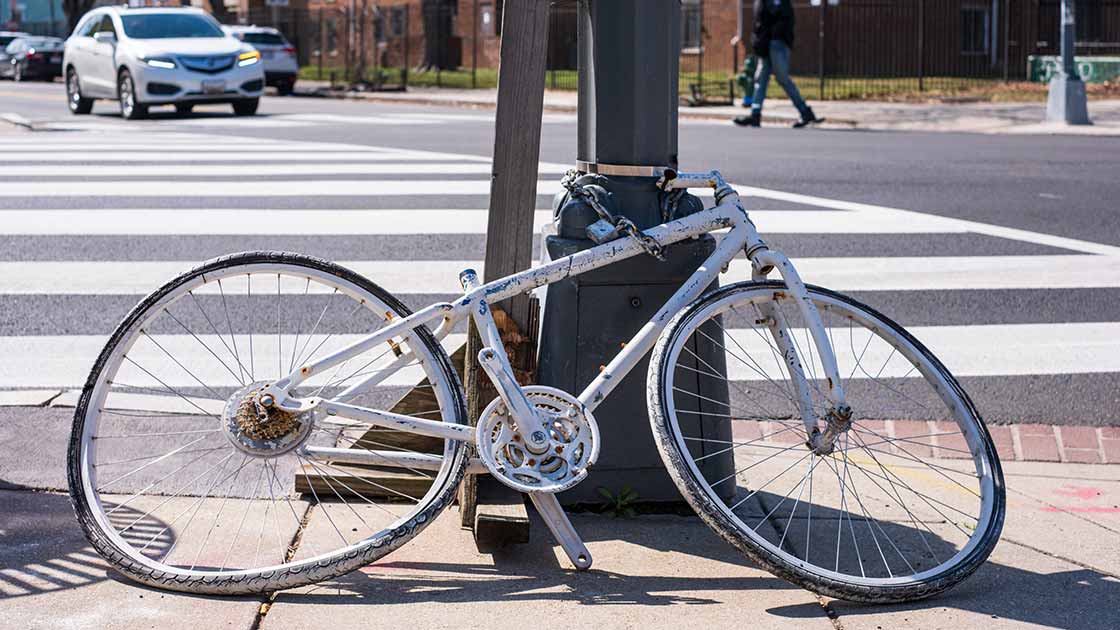
Insurance Institute for Highway Safety, Arlington, Virginia USA, reprinted with permission.
SUVs cause more severe injuries than cars when they hit bicyclists likely because the vehicles’ tall front ends strike the bicyclists higher on their bodies, a new study from the Insurance Institute for Highway Safety shows.
“SUVs tend to knock riders down, where they can also be run over, rather than vaulting them onto the hood of the vehicle,” said IIHS Statistician Sam Monfort, the lead author of the study. “That’s probably because the higher front end of an SUV strikes the cyclist above their center of gravity.”
Ground-impact injuries — a frequent cause of head injuries — were more than twice as common in SUV crashes than those involving cars, the study showed. The findings follow earlier IIHS research that showed SUVs are more lethal than cars to pedestrians despite design changes that have made them less dangerous to other vehicles. That study also traced the increased risk to the height of SUVs’ front ends.
>>Continue reading ...
Fatal bicycle crash rates have risen dramatically over the past decade. In 2020, 932 bicyclists were killed on U.S. roads, up from a low of 621 in 2010. One reason may be the dominance of pickups and SUVs in the U.S. vehicle fleet. Research consistently shows that such larger vehicles are more dangerous to bicyclists than cars.
To try to understand why, Monfort looked at detailed crash data from 71 Michigan bicycle crashes compiled by the International Center for Automotive Medicine’s Pedestrian Consortium. Each crash involved a bicyclist age 16 or older and a single SUV or car. The data included police reports, medical records, crash reconstructions and other information. Monfort used the information to analyze how injuries and other aspects of crashes varied for cars and SUVs. Pickups were excluded from the analysis because the data did not include enough pickup crashes to draw firm conclusions.
Overall, injuries to the lower extremities were common in all 71 SUV and car crashes. Head injuries were common in the most severe crashes but occurred along with other injuries to the torso, abdomen, spine and limbs.
Monfort compared the severity of injuries inflicted by cars and SUVs using the Abbreviated Injury Scale and the Injury Severity Score.
The Abbreviated Injury Scale is used to assess injuries by body region. On it, the average scores for head injuries inflicted by SUVs were 63 percent higher than for those caused by cars. There were no statistically significant severity differences between vehicle types for injuries to other regions.
The Injury Severity Score combines the injuries from the different body regions into an overall assessment. Using that method, trauma to the body as a whole was 55 percent higher for SUVs than for cars.
The records for 23 car crashes and 21 SUV crashes included details about how the bicyclist moved after being struck. In those crashes, only cars caused injuries by vaulting bicyclists onto the vehicle’s roof and only SUVs caused injuries by running bicyclists over.
A smaller group of crashes had details about the part of the vehicle that caused the bicyclist’s injuries. In cars, components spread across the front and top of the vehicle tended to cause injuries. SUVs tended to cause injuries with their wheels or their undercarriage or by knocking the bicyclist to the ground.
The ground, wheels or undercarriage caused 82 percent of the head injuries in the eight SUV crashes. In contrast, the roof, the rail across the top of the windshield or the windshield itself caused all the head injuries sustained in the 10 car crashes.
Taken together, these results suggest that SUVs forcefully knock bicyclists to the ground, where they can be run over by the vehicle as the driver attempts to stop. Even when the bicyclist is not run over, SUV crashes are much more likely than car crashes to result in injuries caused by the bicyclist hitting the ground.
This is different from what the earlier study showed for pedestrian crashes. When an SUV strikes a pedestrian, it’s the direct impact to the pelvis or chest that makes it more dangerous than a car.
Reprinted with permission from the Insurance Institute for Highway Safety. Please visit here for the original article.
»Show less …






